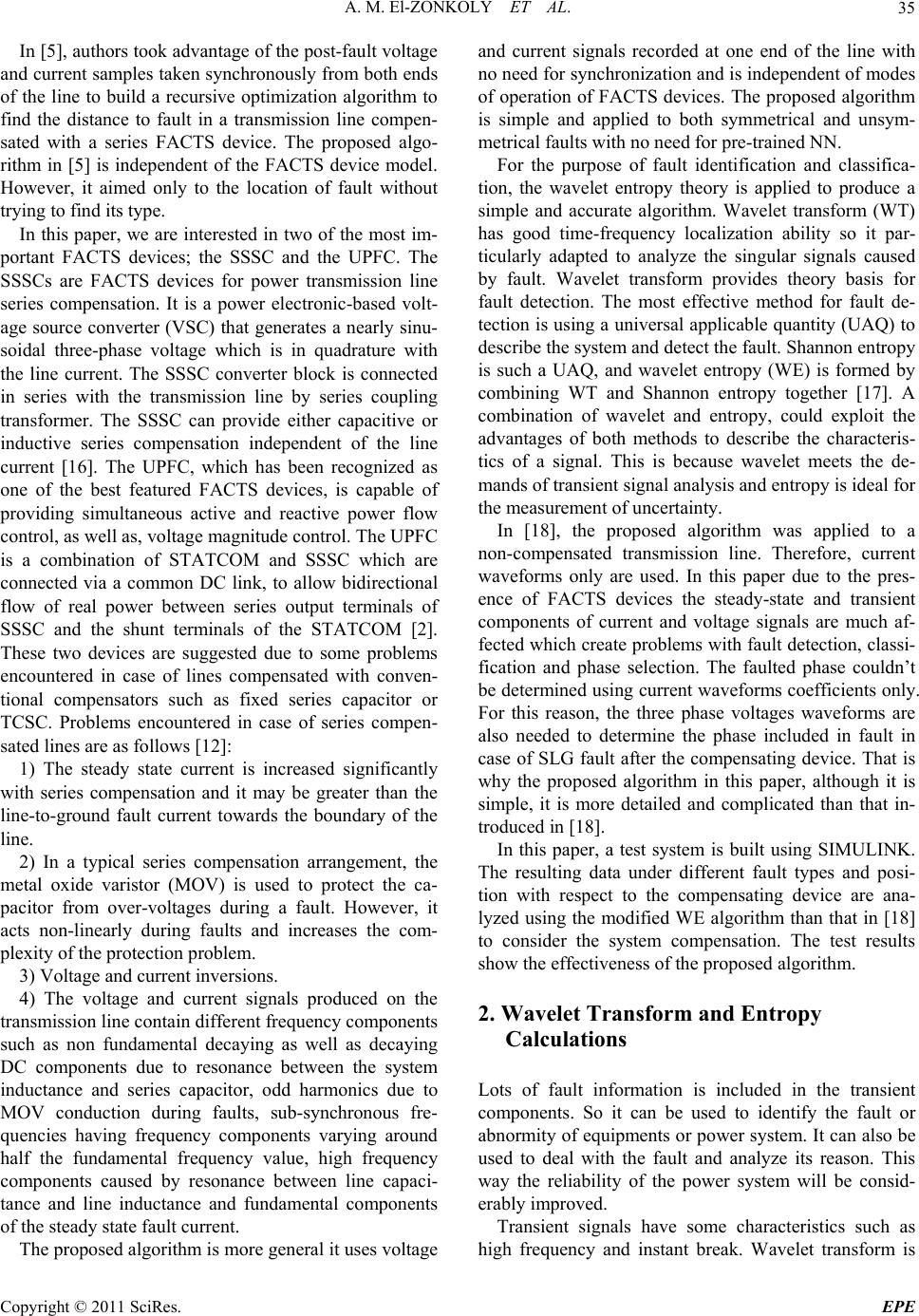
A. M. El-ZONKOLY ET AL.35
In [5], authors took advantage of the post-fault voltage
and current samples taken synchronously from both ends
of the line to build a recursive optimization algorithm to
find the distance to fault in a transmission line compen-
sated with a series FACTS device. The proposed algo-
rithm in [5] is independent of the FACTS device model.
However, it aimed only to the location of fault without
trying to find its type.
In this paper, we are interested in two of the most im-
portant FACTS devices; the SSSC and the UPFC. The
SSSCs are FACTS devices for power transmission line
series compensation. It is a power electronic-based volt-
age source converter (VSC) that generates a nearly sinu-
soidal three-phase voltage which is in quadrature with
the line current. The SSSC converter block is connected
in series with the transmission line by series coupling
transformer. The SSSC can provide either capacitive or
inductive series compensation independent of the line
current [16]. The UPFC, which has been recognized as
one of the best featured FACTS devices, is capable of
providing simultaneous active and reactive power flow
control, as well as, voltage magnitude control. The UPFC
is a combination of STATCOM and SSSC which are
connected via a common DC link, to allow bidirectional
flow of real power between series output terminals of
SSSC and the shunt terminals of the STATCOM [2].
These two devices are suggested due to some problems
encountered in case of lines compensated with conven-
tional compensators such as fixed series capacitor or
TCSC. Problems encountered in case of series compen-
sated lines are as follows [12]:
1) The steady state current is increased significantly
with series compensation and it may be greater than the
line-to-ground fault current towards the boundary of the
line.
2) In a typical series compensation arrangement, the
metal oxide varistor (MOV) is used to protect the ca-
pacitor from over-voltages during a fault. However, it
acts non-linearly during faults and increases the com-
plexity of the protection problem.
3) Voltage and current inversions.
4) The voltage and current signals produced on the
transmission line contain different frequency components
such as non fundamental decaying as well as decaying
DC components due to resonance between the system
inductance and series capacitor, odd harmonics due to
MOV conduction during faults, sub-synchronous fre-
quencies having frequency components varying around
half the fundamental frequency value, high frequency
components caused by resonance between line capaci-
tance and line inductance and fundamental components
of the steady state fault current.
The proposed algorithm is more general it uses voltage
and current signals recorded at one end of the line with
no need for synchronization and is independent of modes
of operation of FACTS devices. The proposed algorithm
is simple and applied to both symmetrical and unsym-
metrical faults with no need for pre-trained NN.
For the purpose of fault identification and classifica-
tion, the wavelet entropy theory is applied to produce a
simple and accurate algorithm. Wavelet transform (WT)
has good time-frequency localization ability so it par-
ticularly adapted to analyze the singular signals caused
by fault. Wavelet transform provides theory basis for
fault detection. The most effective method for fault de-
tection is using a universal applicable quantity (UAQ) to
describe the system and detect the fault. Shannon entropy
is such a UAQ, and wavelet entropy (WE) is formed by
combining WT and Shannon entropy together [17]. A
combination of wavelet and entropy, could exploit the
advantages of both methods to describe the characteris-
tics of a signal. This is because wavelet meets the de-
mands of transient signal analysis and entropy is ideal for
the measurement of uncertainty.
In [18], the proposed algorithm was applied to a
non-compensated transmission line. Therefore, current
waveforms only are used. In this paper due to the pres-
ence of FACTS devices the steady-state and transient
components of current and voltage signals are much af-
fected which create problems with fault detection, classi-
fication and phase selection. The faulted phase couldn’t
be determined using current waveforms coefficients only.
For this reason, the three phase voltages waveforms are
also needed to determine the phase included in fault in
case of SLG fault after the compensating device. That is
why the proposed algorithm in this paper, although it is
simple, it is more detailed and complicated than that in-
troduced in [18].
In this paper, a test system is built using SIMULINK.
The resulting data under different fault types and posi-
tion with respect to the compensating device are ana-
lyzed using the modified WE algorithm than that in [18]
to consider the system compensation. The test results
show the effectiveness of the proposed algorithm.
2. Wavelet Transform and Entropy
Calculations
Lots of fault information is included in the transient
components. So it can be used to identify the fault or
abnormity of equipments or power system. It can also be
used to deal with the fault and analyze its reason. This
way the reliability of the power system will be consid-
erably improved.
Transient signals have some characteristics such as
high frequency and instant break. Wavelet transform is
Copyright © 2011 SciRes. EPE